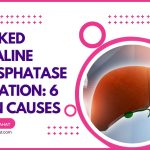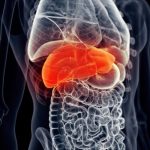What levels of AST & ALT Indicate Dangerous Liver Damage?
Our content is not intended nor recommended as a substitute for medical advice by your doctor. Use for informational purposes only.
Key facts:
- No definitive levels of ALT and AST can accurately assess the extent of liver damage.
- ALT and AST levels in acute hepatitis may reach several thousand (as with acute hepatitis A). However, these levels aren’t considered dangerous with Hepatitis A.
- Liver damage may be reversible (as with acute and chronic hepatitis) or irreversible (as with liver cirrhosis and fulminant hepatic failure).
- In liver cirrhosis (permanent liver damage), liver enzymes don’t reflect the degree of damage. Liver enzymes may be normal or even low in end-stage liver cirrhosis.
- In patients with fatty liver diseases, any levels of ALT and AST above the reference range are considered significant. Levels of ALT or AST 150, 200, or more are considered severe and need immediate attention by your doctor.
- The higher your ALT and AST levels, the more dangerous and the more significant your liver damage.
Table of Contents
1. Understanding liver damage & Its relation to ALT & AST.
A. What do high AST and ALT mean?
ALT (Alanine Aminotransferase) and AST (Aspartate aminotransferase) are found inside your liver cells.
Small amounts of ALT and AST are released into your blood (where they can be measured during blood work).
The excess release of liver enzymes often means accelerated damage to your liver cells.
However, your liver is amazingly capable of regenerating itself. So, the levels of ALT and AST is not always a reflection of dangerous liver condition.
For example, Acute hepatitis A infection may cause severe elevations of ALT and AST levels (usually 2000 to 5000 or more). However, your liver often recovers without significant damage within a few weeks.
On the other hand, some conditions may cause mild to moderate elevations of the ALT and AST levels over a long period causing significant damage to your liver. Famous examples are untreated fatty liver disease, alcoholic hepatitis, and chronic hepatitis C.
So, ALT and AST are only part of the picture. Alone, they are not a reliable indicator of liver damage.
B. Reversible V.S. Irreversible liver damage (and its relation to ALT & AST)
Liver damage is a broad word that can mean different things. This section will help you understand the different types of liver damage and their relation to ALT and AST levels.
To help you understand, we will classify liver damage into two broad categories.
1 Reversible Liver dammage.
- Acute hepatitis.
- Chronic hepatitis.
2. Irreversible liver damage.
- Chronic liver cell failure (liver cirrhosis).
- Acute liver failure (also called fulminant hepatitis).
[1. A] Acute hepatitis (reversible damage)
Acute hepatitis is an acute inflammation and destruction of a large portion of your liver cells. In most cases of acute hepatitis, the liver cells undergo significant but reversible damage.
In people with acute hepatitis, the ALT and AST levels are often over 1000. This is because your liver can regenerate its cells; in most cases of acute hepatitis, the very high levels of ALT and AST levels are not dangerous because the damage is reversible.
Common causes of acute hepatitis:
- Hepatitis A virus.
- Acute hepatitis B.
- Acute alcoholic hepatitis.
- Paracetamol toxicity (with very high doses).
- Acute attacks of autoimmune hepatitis.
- Shock (liver ischemia).
- Preeclampsia and acute fatty liver of pregnancy.
[1. B] Chronic hepatitis (reversible damage, if treated).
Chronic hepatitis is a milder, more prolonged form of hepatitis. The rate of damage to liver cells is often mild to moderate but over a long period (months or years).
This is the most common form of liver damage. The levels of ALT and AST in chronic hepatitis are often mildly elevated.
Any elevation above the reference ranges for your age and gender is liver damage. The higher the degree of elevation, the more liver damage is significant.
Roughly, ALT and AST levels elevation is considered mild when they are below 100 U/L. Significant.
Commonest causes of acute hepatitis:
- Nonalcoholic fatty liver disease.
- Alcoholic liver disease.
- Chronic hepatitis B and C.
- Autoimmune hepatitis.
- Hemochromatosis.
[2. A] liver cirrhosis (chronic liver cell failure).
Liver cirrhosis is permanent damage to your liver cells and the loss of their unique structure. Liver cirrhosis results from untreated chronic hepatitis, such as hepatitis C, autoimmune hepatitis, and alcoholic liver disease.
In people with cirrhosis, ALT and AST levels often don’t reflect the degree of damage. Moreover, Below-range levels of ALT and AST may be a bad indicator (it means depletion of the functioning liver cells).
[2. B] Acute liver failure (fulminant hepatitis).
A small subset of patients with acute hepatitis may progress into acute fulminant liver failure.
In this condition, prolonged elevations of ALT and AST levels for weeks (together with high bilirubin, low albumin, and low prothrombin).
However, The levels of ALT and AST are also not reflective of the severity of the condition in all case scenarios.
For example, acute liver failure may result from very high bilirubin levels (most due to drug-induced cholestasis). In drug-induced cholestasis, acute liver failure can occur with normal or slightly elevated liver enzymes.
2. What are the dangerous levels of ALT and AST?
There are no definite ALT or AST levels that are dangerous. It depends on the cause of elevation, the duration of the elevations, and other tests of liver functions (Such as bilirubin, albumin, and prothrombin levels).
Also, we use other non-laboratory indicators of liver damage, such as your clinical condition, liver imaging, etc.
Your doctor should investigate any elevated ALT and AST levels above reference ranges.
In acute hepatitis, the levels are often very high, but the damage is often reversible. So, very high ALT & AST levels are often not dangerous unless they are persistent for several weeks or are associated with signs of acute liver failure.
In chronic hepatitis (such as alcoholic hepatitis and fatty liver, persistent elevations of the liver enzymes of 5 or more times the upper limit of normal (ALT & AST levels of 150-200) or more are considered dangerous.
Moreover, even mild elevations of liver enzymes (ALT & AST levels between 50-150) can cause significant liver damage after several years.
In conclusion, any persistent elevations in your liver enzymes can cause damage to your liver, but the process may take years (if not decades).
The table below illustrates the reference ranges of ALT and AST levels for adult men and women.
3. How does your doctor Assess liver damage (other than AST and ALT)?
AST and ALT are only parts of the whole picture. The liver damage (whether reversible or reversible) is evaluated based on clinical, imaging, and laboratory findings.
Also, the original cause of the AST or ALT elevation and the time frame of abnormal liver functions will help assess the extent of the damage.
Liver inflammation is a form of reversible damage (either acute or chronic). But liver fibrosis or cirrhosis is another form of permanent liver damage.
ALT and AST are only capable of detecting liver inflammation. But they cannot assess the degree of liver fibrosis or cirrhosis.
To Assess liver damage, your doctor will:
- Take an accurate history: to assess the cause of ALT and AST elevation. Also, he will ask you about the symptoms of liver inflammation (jaundice, liver pain, clay stools, change in the color of urine, etc.).
- Ask about the cause, such as diet habits, alcohol intake, fever, history of hepatitis virus infection, recent drug or herbal intake, etc.
- Ask about the symptoms of liver cirrhosis (permanent liver cell damage), such as swollen limbs, weight loss, swollen abdomen (ascites), vomiting of blood, or coma.
- Perform a clinical examination: to search for signs of liver damage such as jaundice, lower limb swelling, liver enlargement, etc.
- Request whole blood work to assess the extent of liver damage: ALT, AST, alkaline phosphatase (ALP), Gamma-glutamyl transferase (GGT), bilirubin (total and direct), serum albumin, prothrombin time.
- Investigate for the cause: virus workup (testing for hepatitis A, B, C, etc.), Iron profile, copper levels, Antibody testing for autoimmune hepatitis, etc.
- Imaging includes abdominal ultrasound, abdominal C.T., and transient elastography (to assess liver fibrosis).
- Your doctor may take a liver biopsy which is an accurate tool to assess the extent of liver damage.
Your doctor can only assess the liver damage based on a combination of your symptoms, clinical signs, laboratory tests (liver enzymes and other liver function tests), liver imaging, and maybe a biopsy.
ALT and AST levels alone are not reliable indicators of liver damage. Moreover, the danger levels of ALT and AST differ according to the nature of the disease.
MORE: Can Liver Function Tests be Normal with Cirrhosis?
- Evidence-based
- Written by a doctor.

Related Posts:
- Marked Alkaline Phosphatase Elevation (levels over…
- Typical & Atypical Bilirubin levels in cirrhosis…
- 11 Evidence-Based Foods To Lower Cholesterol Levels…
- Liver Complications after Bariatric Surgery.
- 5 Causes of Elevated Liver Enzymes & Negative Ultrasound
- How Long does it Take to Reverse a Fatty Liver? (5 Facts).





